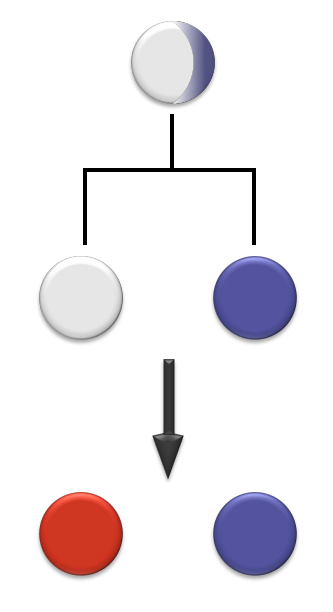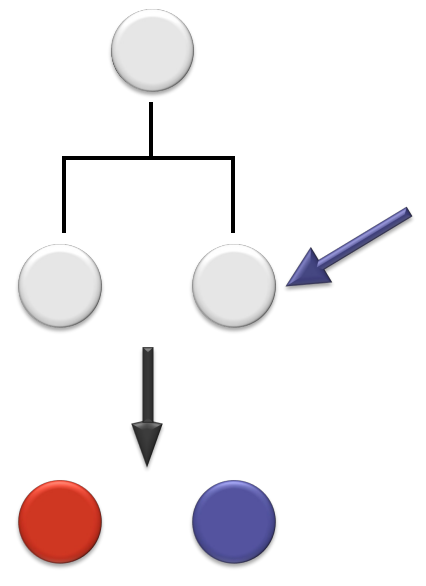biology 302 exam 4
1/108
Name | Mastery | Learn | Test | Matching | Spaced |
|---|
No study sessions yet.
109 Terms
what is the “genetic” approach to studying a biological problem?
look for mutants in which the process is defective
what is spontaneous?
uncorrected errors in DNA replication and natural mutagens (xrays, gamma rays, UV light)
what is induced?
expose population to mutagen
what is the genetic approach to understand a process?
do mutagenesis
- perform a mutant “screen”
what is mutagenesis?
expose a population to mutagen
what is mutant screen?
look for mutants that have a phenotype affecting the process of interest
what did beadle and tatum do?
a genetic screen for neurospora mutants which had defects in biochemical pathways for making vitamins and amino acids
what is the plan of beadle and tatum’s experiment?
isolate auxotrophic mutants which can’t make specific vitamins or amino acids
what happens if you expose the haploid spores to a mutagen?
it introduces random mutations in the genes
where can wild type e.coli grow?
on plates containing only lactose
what are lac- mutants?
auxotrophic mutants that were unable to grow with lactose as an energy source
what are lacc mutants?
mutants that expressed the lac operon genes constitutively, even in the absence of lactose
what are lacl^s mutants? (superrepressor)
mutants that never expressed the lac operon genes, even in the presence of lactose
what is the 1st step of genetics to study a biological process?
genetic method in the single cell eukaryote yeast to understand regulation of the cell cycle
what is the 2nd step of genetics to study a biological process?
genetic method in the plant to understand control of flower development
what is the 3rd step of genetics to study a biological process?
genetic method in the nematode roundworm to understand control of cell fate specification during animal development
why do geneticists use brewer’s yeast to study basic processes that occur in eukaryotes?
- single celled
- basic cellular processes are the same as more complex, multicellular animals
- fewer genes than in multicellular
what happens during a mitotic cell cycle?
1 cell divides into 2 → mother cell budding off a new daughter cell
what did hartwell do to study the eukaryotic cell cycle?
mutagenized yeast, then screened temp-sensitive mutants that couldn’t complete the cycle
- grow the mutagenized cells at 23°
- make a copy of the plate
- shift 1 copy to 36°
- look for colony that grows on 23°; not 36°
what was the end product of hartwell’s experiment?
dozens of temp-sensitive mutant strains w/ a mutation in each strain
what did hartwell call the temp-sensitive mutant strains?
cdc genes = cell division cycle mutant
what was the conclusion of hartwell’s experiment?
the mutated gene makes a protein required to proceed thru that specific step in the cell cycle
what did they find out about cdc genes?
conserved in eukaryotes, and controlled the cell cycle in other species
what are homologous genes/homologs?
a gene present in 2 species b/c of descent from a common ancestor
what is the ‘model system’ approach?
taking the genetic approach to study a process in a simpler species can yield results relevant to other species
why does the model system approach work?
because genes are conserved and perform the same/similar functions in different species
where do stem and branches grow from?
shoot meristem
where do roots grow from?
root meristem
where do flowers grow from?
inflorescence (flower) meristem
how is the flower in Arabidopsis thaliana organized?
4 whorls
what is whorl 1?
sepal
what is whorl 2?
petal
what is whorl 3?
stamen = makes male gametes (pollen)
what is whorl 4?
carpel = makes female gametes (ovule)
what did elliot meyerowitz at the caltech lab do?
mutant screen and identified mutants in which flowers developed incorrectly
what did elliot meyerowitz screen in the Arabidopsis thaliana flower experiment?
mutants in which the wild type flower structure was not made
what are the 3 classes of the Arabidopsis thaliana flower mutants?
- no sepals/petals
- no petals/stamens
- no stamens/carpels
what does the wild type of the Arabidopsis thaliana flower look like?

what did elliot meyerowitz hypothesize?
whorl identity is controlled by the combination of genes expressed in that whorl
what does whorl 1 do?
has class A genes - tells cells to form sepal
what does whorl 2 do?
has A + B genes - tells cells to form petal
what does whorl 3 do?
has B + C genes - tells cells to become stamen
what does whorl 4 do?
has C genes - tells cells to become carpel
whorl identity model

when the genes are identified, what did the transcription factors encode in the flower experiment?
express where the model predicted, combine with each other in pairs, regress each other’s expression, regulate downstream targets to specify organ made
where do all complex, multicellular organisms develop from?
a single cell; fertilized egg
what is undifferentiated?
has not adopted a distinct cell fate
what are cell intrinsic factors?
traits that are “intrinsic” to a person rather than being determined by that person's environment

what is extracellular signaling?
cues designed to transmit specific information to target cells

what are the vulva precursor cells (VPCs)?
cells in the skin of the animal (hypodermis)
where do VPCs sit?
underneath the anchor cell (AC) → cell in the gonad
are the VPCs born knowing their fate or are they instructed?
VPCs born not knowing what fate to adopt, anchor cell must tell them to adopt the 1° and 2° fates
what causes cells to adopt the vulva fates?
activation of the RAS pathway
what is cancer?
uncontrolled and inappropriate growth of cells
what is a benign tumor?
tumor that remains in the spot where it grew; usually not dangerous unless it presses on other organs
what is a malignant tumor?
a tumor that can invade surrounding tissue and spread
what is a metastatic tumor?
a second tumor caused when cells from the primary tumor move thru the body to colonize a new site
what is cancer a group of?
disorders characterized by the overgrowth of cells in different organs/tissues of the body
what are some common properties of cancer cells?
- evading apoptosis
- self-sufficiency in growth signals
- insensitivity to anti-growth signals
- sustained angiogenesis
- tissue invasion and metastasis
- limitless replicative potential
how do cancer cells divide?
uncontrollably
what are growth factors?
proteins secreted by cells that cause other cells to divide by ‘pushing’ them into the cell cycle
- bind receptors on the cell surface
what happens when the growth factors bind?
it activates signaling pathways that turn on expression of genes that instruct the cell to move thru the cell cycle and divide
do cells need growth factors?
no
what is apoptosis?
a damaged cell commits suicide by an orderly destruction of the cell (without causing an inflammatory response)
what do cancer cells display?
transformed phenotype in tissues
what is angiogenesis?
formation of blood vessels
what is tumor angiogenesis?
cancer cells can recruit blood vessels to themselves, allowing a tumor to grow beyond a certain small size
what happens if cancer cells move away from their site of origin?
they enter the bloodstream and move to a new site in the body
what type of disease is cancer in humans?
genetic
what percent of the time is the cancer sporadic?
90%w
what percent of the time is the cancer hereditary?
10%
what is clonal?
all cells in the tumor are progeny of 1 cell
what is the ‘multi-hit model’ for carcinogenesis?
cells becoming cancerous is a rare event that only happens after a number of key genes have been mutated in the same cell
what are oncogenes?
genes in which gain-of-function mutations contribute to cancer
what manner do oncogenes act in?
dominant
how many mutated copies does oncogenes need?
one
what are proto-oncogenes?
normal genes
what is Ras/GTPase?
protein found on the inside of the plasma membrane
what is the function of Ras/GTPase?
acts as a switch
- GDP bound, it is off
- GTP bound, it is on
what are tumor suppressor genes?
genes in which loss-of-function mutations contribute to cancer in a recessive manner
what is the cell cycle checkpoint?
a point in the cell cycle in which the state of the DNA or chromosomes is checked, and if it is not correct, then the transition to the next stage doesn’t happen
where is damaged DNA checked for?
- G1/S
- S phase
- G2/M
what is p53?
a transcription factor protein that turns on the expression of many genes
what is the Mdm2 protein?
it exports p53 from the nucleus into the cytoplasm, where it is destroyed
what happens when damaged dna is detected?
p53 senses the damaged dna, p53 is not destroyed and moves into the nucleus to turn on genes:
- genes that cause the cell cycle to arrest
- genes that encode dna repair enzymes
what does p53 turn on if damage is really bad?
genes that cause apoptosis
what happens with a loss of p53?
eliminates the dna damage cell cycle checkpoints
what kind of mutations are in the BRCA1 and BRCA2?
germline mutations
what does mutations in BRCA1 and BRCA2 predispose a person to?
breast and ovarian cancer
what are the percentages for breast cancer?
- 12% of women will develop breast cancer at some time in their lives
- 60% of women who inherit the BRCA1 mutation will, by age 70
- 55% of women who inherit the BRCA2 mutation will, by age 70
what are the percentages for overian cancer?
- 1% of women will develop ovarian cancer at some time in their lives
- 60% of women who inherit the BRCA1 mutation will, by age 70
- 15% of women who inherit the BRCA2 mutation will, by age 70
what is the hayflick limit?
normal cells, when placed in tissue culture, can divide their dna about 50 times
what is replicative senescence?
normal cells are unable to divide after the hayflick limit
why does replicative senescence occur?
there is no expression of telomerase gene in most differentiated cells, and telomere ends degrade
how do cancer cells bypass replicate senescence?
they turn expression of telomerase back on = immortal
what is biotechnology?
the field of applied biology in which living organisms, or processes from living organisms, are used, usually w/ human modification, to serve some some scientific or medical purpose
genetic engineering
methods that rely heavily on knowledge from basic research into the genetics and molecular biology of model organisms
what is a genetically-modified organism?
an organism which has had its genome modified in some way by human intervention
what is the first reason for GMOs?
to make large quantities of a protein or drug in bacteria, animals, or plants
what is humulin?
human insulin made in bacteria